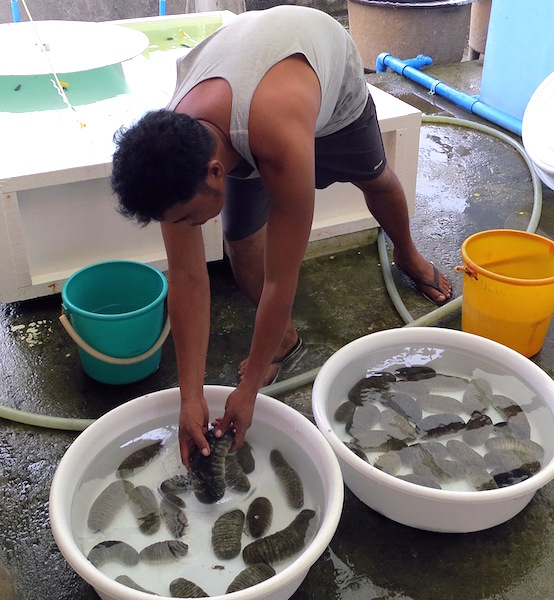
Features
Research
Hatchery production the key to Philippine push into sea cukes
March 2, 2017 By Ruby Gonzalez
 Sandfish (Holothuria scabra) commands top price
Sandfish (Holothuria scabra) commands top priceThe Philippines, at one time the world’s largest producer of high-value sandfish (Holothuria
scabra), wants to bank again on this economic opportunity.
When processed as sea cucumber meat products, sandfish and golden sandfish (H. lessoni), another species available in the country, command as much as $1670 a kilo in China, the world’s biggest market for such products.
Propping up this objective is the industry’s Strategic S&T Program for Sea Cucumber, which was launched in 2012 by the Department of Science and Technology – Philippine Council for Agriculture, Aquatic and Natural Resources Research and Development (DOST-PCAARRD).
It bats for the restoration of depleted populations and production of premium-sized sandfish.
With its comprehensive approach that involves all stages, from larval rearing to post-harvest processing, this program is seen as essential to creating interest in the Philippines.
A need for hatcheries
“No study has been conducted yet to look into the economic viability of a stand-alone sandfish hatchery in the Philippines. Currently, research-based hatcheries produce sandfish for experiments and small-scale culture trials,” Dr. Jon Altamirano told Hatchery International. Altamirano is an associate scientist at the Aquaculture Department, Southeast Asian Fisheries Development Center (SEAFDEC/ AQD) in Iloilo, Philippines.
“Economic analyses using research-based operations will tend to be unrealistic and some business-based sandfish hatcheries are still experimenting. Commonly, trial hatchery production runs of sandfish were done by incorporating sandfish and additional species into an already existing hatchery for finfish, crustaceans or shellfish. Commercial production of sandfish is still challenged by a lack of potential clients for grow-out culture of the species,” he said.
Since 2010, SEAFDEC has been offering a training course, Sandfish hatchery, nursery operations and management, at its Iloilo station.
Sea cucumber hotspot
“Interest in sea cucumbers has indeed been increasing but not steadily, with an average of five to 10 participants. In the past three years, we received more participation from foreign countries than from the Philippines. Also since 2013, we needed to offer two courses in a year to accommodate increasing requests for training.”
The Philippines is a recognized sea cucumber hotspot with 200 species. Of its 35 common commercial sea cucumber species, half are high- and medium-value. To compare, there are around 1,400 species of sea cucumbers worldwide and only 60 are commercially important.
From its heyday of being the world’s top producer, the Philippines has dropped to the eighth slot with less than a thousand tons, per FAO 2015 report. Its biggest recorded production was in 1990 with 4,000 tons.
Diversified systems
Sea cucumber farming involves a grow-out period that sometimes takes more than two years and could have low post-release survival. To make sea cucumber farming profitable, the study cited the importance of reducing the cost of juvenile production.
A low-cost nursery system was developed to reduce cost and diversify systems for juvenile production. This technology makes it accessible to small-scale growers as well.
The inexpensive and readily available materials include fine-mesh nets and PVC pipes to make hapa cages.
“The system involves a combination of different land and ocean-based nursery and grow-out systems to scale up sandfish production depending on the biophysical conditions and culture facilities in a particular locality,” the study cited.
Post-metamorphic juveniles, sized 4 mm, are reared to release size of over 3 grams for up to 60 days in hapa nets in marine ponds. Sandfish are harvested at 320 g. When fully dried, this shrinks to 5 cm, which is the minimum size required by the Philippine National Standards for dried sea cucumber products.
— Ruby Gonzalez
Print this page
Advertisement
- UK power firm commits £750,000 to new salmon hatchery
- Towards zero liquid discharge: Denitrification and refractory organic cleanup in RAS





